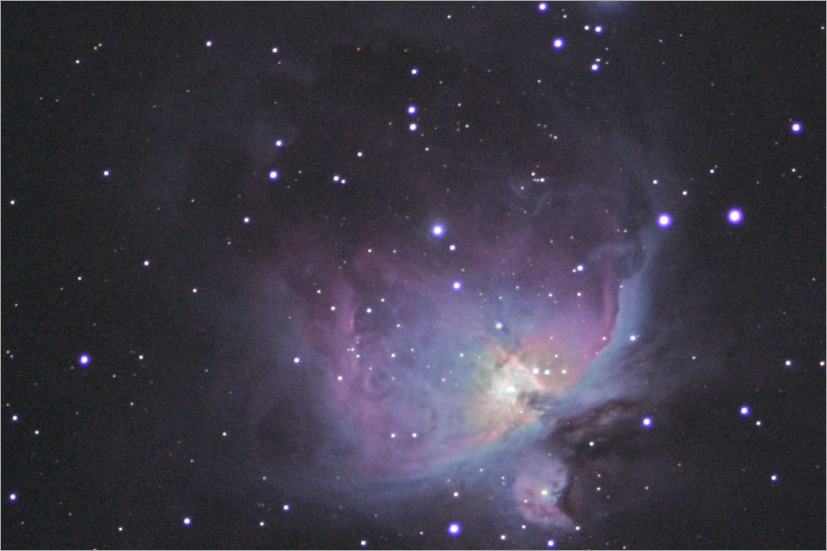
High Dynamic Range Image
M42, The Orion Nebula
The range of brightness in the Orion Nebula is too great to record in one single exposure.
Long exposures are used for the faint outer parts of the nebula, and shorter exposures are used for the bright inner core around the Trapezium.
The long and short exposures are then combined in post processing to create a high dynamic-range (HDR) image that has detail in both the faint and bright parts of the nebula.
|
|
M42 is the Great Nebula in Orion.
The Orion Nebula complex is undoubtedly one of the most famous and beautiful areas of the entire night sky. It is easily visible to the unaided eye from a dark location as a patch of brightness surrounding Theta Orionis, the middle star in the sword of Orion the Hunter, the constellation which dominates the winter night sky.
Located about 1,350 light years away, the nebula glows red predominantly from the light of hydrogen gas excited by energetic newly-formed stars in the heart of the nebula. It is the nearest star forming region to our own star, the Sun.
Some deep-sky objects, such as M42, have a large brightness range that makes it nearly impossible to record detail in both the bright and faint parts in a single exposure. Digital cameras, and even film for that matter, do not have that much dynamic range.
Long exposures are needed for the faint portions, and short exposures are needed for the bright parts. We can overcome this problem by combining exposures of different lengths into a single picture that captures the entire dynamic range of the subject.
Image Data
- Lens / Scope: Stellarvue SV70ED ED doublet refractor
- Focal Length: 420mm
- F/stop: f/6
- Exposure: Stack of seventeen frames (25.5 minutes total exposure)
- 2 x 15-second exposures
- 3 x 60-second exposures
- 11 x 120-second exposures
- Mount: Orion Sirius polar-aligned German-equatorial mount
- Guiding: None
- Camera: Unmodified Canon EOS 1000D (Digital Rebel XS)
- Mode: JPEG
- ISO: 1600
- White Balance: Custom, set on sky background
- In-Camera Noise Reduction: Off
- Filter: None
- Temp: 28F and 35F
- Start Time: 10:05 and 8:46 p.m.
- Date: March 20 and 24, 2009
- Location: Maxwell, NJ
- Calibration: None
- Processing: Standard in-camera JPEG processing. Stacked in Deepsky stacker. Exposure groups combined with layer masks in Photoshop to create the high dynamic-range image.